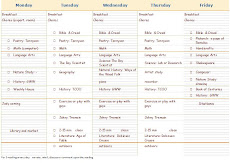Anyway, since Paddy is so young (four) and is much more "literature-oriented" than Aidan, I wanted to try to work with him a bit in the Treadwell style and see what happened.
Besides the Primer, here are some cards -- on the big light green one I wrote down all the words used and all the consonants and blends (using phonogram charts like this one and this one at the excellent Don Potter phonics site).
 Then on the small yellow cards I wrote down all the words individually, and on the small green cards I wrote down the individual-letter phonograms. The blends are in yellow, underlined, to visually demonstrate they are blends.
Then on the small yellow cards I wrote down all the words individually, and on the small green cards I wrote down the individual-letter phonograms. The blends are in yellow, underlined, to visually demonstrate they are blends.
The book about Teaching Reading includes two sets of lesson plans for using the primers to teach beginning reading. NOW -- the approach is a blend of "whole language" with teaching systematic phonics following closely. To me, the amateur, this approach seems to make sense. However, most of the proponents of straight phonics I have read recommend NOT confusing the child with whole word reading except in very limited circumstances. So I'm trying it with Paddy because he's very young and if I make a false step, we can take a break for a month or so and then start afresh. On the bright side, WRTR shows how almost ALL the words in the English language have logical phonetic consistency, so "whole language reading", in the homeschool, can easily go right alongside phonics explanations, if you know your phonograms.
To take an example -- Writing Road to Reading introduces "do" as one of the first five words to spell. The "o" sounds like "oo", and this is the third sound for "o" and one that is relatively uncommon. Samuel Blumenfeld, in Alphaphonics, doesn't teach this sound till much farther along. He starts in the ordinary phonics- oriented way with short vowel sounds, then some consonant blends, etc.
Sorry to go on so looong -- I suppose I am assimilating -- narrating -- as I go!
Anyway, Paddy and I had a lesson where I wrote "the little red hen" on the whiteboard and then got him to match the cards with the words on the board. He was mildly interested but not as enthusiastic as AIdan was about his pink cards. But I'm going to keep trying, about three times a week. The nice thing about a Literature approach to reading is that you can easily extend the lessons to words in his Read Alouds. Several of my kids would have absolutely hated me distracting them from the story by talking about letters and sounds, but as I've mentioned before, Paddy spontaneously asks about titles and words and asks -- DEMANDS -- for me to follow the words I'm reading with my finger as I read. So with him, I want to explore a natural approach like Scout Finch's with her father.
Paddy retelling his "Wall Story" -- this was his idea~!




Willa, I have one child, my dd, who just did NOT take to straight phonics, with a capital N! She is so bright in so many ways, but the phonics just did not make sense. We basically went to just reading together, her out loud to me. I was also a little wary of mixing up the whole language and phonics as most homeschoolers seem to be so insistent on the phonics only. But this is what has worked with her. She is just fluent now at 10, and is reading up the HP books slowly but surely and loving it.
ReplyDeleteI also used the Treadwall primers with my 7yo and he enjoyed them!